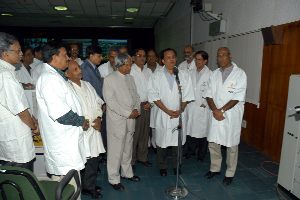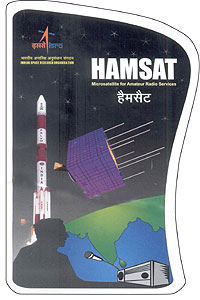

|
HAMSAT - VUSAT
HAMSAT is a
microsatellite for providing satellite based Amateur Radio Services to the
national as well as the international community of Amateur Radio Operators
(HAMs). Launched as an auxiliary payload along with CARTOSAT-1, the 42.5
kg HAMSAT will meet the long felt need of the Amateur Radio Operators in
the South Asian region who possess the required equipment and operate in
the UHF/VHF band based satellite radio communication. One of the
transponders of HAMSAT has been developed indigenously involving Indian
HAMs, with the expertise of ISRO and the experience of AMSAT-INDIA. The
second transponder has been developed by a Dutch Amateur Radio Operator
and Graduate Engineering student at Higher Technical Institute, Venlo,
HAMSAT is
India�s contribution to the international community of Amateur Radio
Operators. This effort is also meant to bring ISRO�s satellite services
within the reach of the common man and popularise space technology among
the masses. This satellite will play a valuable role in the national and international scenario by providing a low cost readily accessible and reliable means of communication during emergencies and calamities like floods, earthquakes, etc. Besides, it will stimulate technical interest and awareness among the younger generation by providing them with an opportunity to develop their technological projects including offering a platform. Some of the new technologies being tested in HAMSAT include Integrated Processor based Electronic Bus Management Unit, Lithium Ion Battery and Gallium Arsenide based Solar Panels.
Source Credit: www.isro.org India gives global Ham operators own satellite
May 2, 2005 - India has a gift for Ham radio operators worldwide - an exclusive satellite to be launched on Thursday that they can access for free. The 42.5 kg micro-satellite is one of two that will be sent aloft from this launch pad that day. Today, there is no HAMSAT in the skies, the last one having died two years ago. That was the American AMSAT.  A Big Thank You! AMSAT INDIA thanks ISRO Amsat India the organization of Hams for Indian Amateur Satellite Programme thanks ISRO for dedicating an exclusive satellite for Radio Amateurs and successful launch, which will benefit the hams not only in India but all International Hams operating the satellite modes.
Air Cmde Suby - VU2UV |
Project OSCAR (Orbiting Satellite Carrying Amateur Radio), a west coast USA-based group which built and launched the very first amateur radio satellites began in 1961. OSCAR I was launched on December 12th, 1961 barely four years after the launch of Russia's first sputnik. OSCAR I was followed by OSCAR II six months later. These satellites were built, quite literally in people's basements and garages. Originally these were "bleep sats" but now they carry sophisticated repeaters or transponders.
Even today's satellites give out bleeps (beacons) on a particular frequency so that you know the satellite is passing by. The time the satellite is visible (in range) to an observer is called a satellite "pass". During the pass, you are in the "footprint".
Communications satellites are put into orbit by means of rocket-powered launch vehicles, or boosters. Most are placed into geostationary orbit, in which the satellite follows a circular path around the Earth in the plane of the Equator, at an altitude of 35,900 km (22,300 miles). At this height the satellite's period of revolution around the Earth is the same as the Earth's period of rotation, so that the satellite maintains a continuous position above the same spot on the globe.
A satellite can be put into any of the following orbit types:Throughout its service life, a satellite must be maintained in the correct attitude (i.e., pointing in the right direction). Attitude is controlled by one of three methods: "spin-stabilizing" the entire satellite, including the antennas; spinning the body of the satellite while the antenna platform is "despun," or counter-rotated, in order to point stably at some point on Earth; and maintaining "three-axis" stability of the entire satellite by means of an internal gyroscope and small thruster jets.
Source: www.spacetoday.org
The successful launch of PSLV-C6 by ISRO is a history-making accomplishment with India achieving its first presence of amateur radio satellite in space.
Congratulations to the HAMSAT Team and Chairman ISRO. This achievement is due to tireless work of many Scientists, Engineers of ISRO, Hams in India and around the world, who have helped accomplish this momentous task.
HAMSAT's polar sun synchronous orbit is some 618 km above Earth. Among other capabilities, the 42.5 KG, 24-inch-cuboid microsat--equipped with a transmitter capable of up to 1 Watt output--will allow voice communication using FM, SSB and CW (Morse Code –
Radio Telegraphy).
We count on this launch as a step forward in the development of our country and the whole south Asia region. Today, we are getting the capability of covering the Indian sub continent with a simple handheld transceiver and getting into the club of countries that possess ability to design, building, integration, testing and launching of amateur radio satellites.
We're really excited of the fact that this satellite program has made technology available to common man through amateur radio. We have established ourselves as capable to achieve our goals, encourage youth to experiment new technologies, help in providing communication during emergencies, help develop rural areas with amateur radio communications.
We would like to take this as a stepping stone for future development and hope ISRO would go further ahead, with the experience gained during the first launch to continue in building programs in amateur satellite communication.
Once again, Congratulations to ISRO and HAMSAT team for making Indian Hams proud with an indigenous amateur radio satellite.
S.Suri (VU2 MY)
Founder, Chairman - NIAR
Small satellites, which are cheaper and quicker to build, are also a low-risk way to test new technology.
HITCHHIKING ON the Polar Satellite Launch Vehicle (PSLV) earlier this month alongside the 1,500 kg Cartosat-1 earth observation satellite was a small box-like satellite weighing just over 40 kg. It was Hamsat, a microsatellite built by the Indian Space Research Organisation with the help of amateur radio operators (known as hams) in India and in the Netherlands. Acting as a relay station high up in the sky, the satellite gives hams an easy and reliable way to communicate across vast distances.
Hamsat is the smallest satellite ISRO has built in recent times. The last time it made such light-weight satellites was 20 years ago when it developed the Rohini series, which too weighed around 40 kg, to fly experimental spacecraft on India's first launch vehicle, the SLV-3. Since then, ISRO's operational satellites for communications and earth observation have grown bigger and heavier.
The first of the Insat-4 communication satellites that ISRO plans to launch in a few months' time will, at over three tonnes, be two and a half times heavier than the Insat-1 satellites launched in the 1980s. Similarly, Cartosat-1 is one and a half times heavier than the IRS-1A launched in 1988.
Low cost
There is now worldwide interest in small satellites as they are cheaper and quicker to build. Hence, they are a low-risk way to test new technology. The European Space Agency recently issued a press statement saying that Proba, a washing machine-size earth observation satellite launched on the PSLV in October 2001 as a one-year technology demonstrator, was continuing its high-quality performance. It was making "a big contribution to science." Images supplied by its cameras were being used by some 56 scientific teams for a range of applications from studying vegetation and water quality to assessing the productivity of vineyards.
Surrey Satellite Technology Limited (SSTL) in the United Kingdom, world leaders in small satellites, has created a `Disaster Monitoring Constellation' with four earth observation satellites that were built for Algeria, Nigeria, Turkey and the United Kingdom; a fifth satellite for China is to be launched later this year. With four satellites in orbit, the constellation is able to image every part of the Earth every day.
Hamsat is part of ISRO's efforts to benefit from small satellite technology. Hamsat was built in two years at a cost of just Rs.3 crores, according to K. Thyagarajan, who heads the small satellite programme at the ISRO Satellite Centre in Bangalore. As the satellite handles orbit-keeping functions autonomously, ground operators need to check the satellite only once every few days. One of the satellite's two transponders (which receives radio signals from ham sets and then relays them back to the ground) was supplied by a ham enthusiast in the Netherlands and Indian hams have been involved in the satellite's development and testing.
Hamsat spins at about four revolutions a minute to maintain stability while orbiting the earth. ISRO is developing the basic structure for small satellites weighing around 100 kg that do not need to spin. The 90 kg TWSAT is intended by ISRO as an earth observation satellite suitable for Third World countries. User terminals for receiving data from this satellite would be installed in Indian universities and some Third World countries, according to the Department of Space's annual report.
Hams in India and abroad are delighted with Hamsat. After Project OSCAR when a U.S. based group built and launched the very first amateur radio satellite in 1961, a number of such satellites have been put into orbit, observes Air Commodore (Retd.) V. Subramanian, president of AMSAT India. AMSAT India was formed in 2001 by Indian hams to promote the development and use of amateur radio satellites.
Hamsat has already become the most popular amateur radio satellite among Indian and foreign hams as it relays voice signals rather than the more sophisticated digital communications, says Pratap Kumar, secretary of AMSAT India. Anyone with a simple handset can access it and reach fellow hams up to a few thousand kilometres away. On the very first day Hamsat became available for use, he was able to contact a person in Malaysia, Mr. Kumar told The Hindu.
By N. Gopal Raj -
The Hindu

| Go Back | Go Top | Go Home |